The vintage electronic equipment enthusiast who wishes to have some basic understanding of the principles of operation of his equipment is faced with the challenge of finding expository material which covers electron tubes in an elementary manner. The vintage expository material which survives is generally suitable for engineers and contains advanced concepts, whereas elementary modern material, while very available, does not cover principles used in electron tubes. This document attempts to present, in an elementary manner, the basic functioning principles of electron tubes.
In 1873 Frederick Guthrie discovered that a positively charged electroscope could be discharged if a grounded piece of white hot metal were brought near it, whereas a negatively charged electroscope could not. Apparently, hot metal was capable of emitting negative charge.
On February 13, 1880 Thomas Edison rediscovered this effect. Carbon filaments in electric light bulbs always burned out at the positive connected end. Edison had a metal plate sealed into a bulb, and verified that there was a current which flowed through the vacuum, but only when the plate was positive. Edison saw no usefulness to this effect, and never made anything of it, though this is the origin of the diode.
In 1897 John Fleming in England realized that this effect could be used as a sensitive and precision radio detector, and received a patent on November 16, 1904 in Britain and November 1905 in the U.S.A. for what came to be called the fleming valve. This was the beginning of the electron tube era.
In 1897 J. J. Thomson discovered the electron.
In 1907 Lee de Forest added a control grid, creating the triode. This allowed electron tubes to be used as amplifiers, making possible transmitters operating at much higher frequencies where antennas are more effective, and much more sensitive receivers, vastly extending the range of radio transmissions. It also allowed the use of the loud speaker, so more people could listen at one time.
About 1926 Dr. A. W. Hull added a screen grid, creating the tetrode. A few years later he added the suppressor making a pentode. These two additions made electron tubes much easier to use as high frequency amplifiers, and increased the gain and power available in low frequency amplifiers.
Electron tubes may be categorized in various ways, as by degree of evacuation, type of cathode, number of electrodes, number of units, or intended function, and by other means as well.
Diodes have two active electrodes, triodes have three, and tubes (e.g. photomultipliers ) with as many as twenty or even more electrodes exist.
Tubes may contain more than one useful unit within one evacuated chamber, as in twin triodes (12AX7), which contain two identical triodes, or dual diode + triode tubes (12AV6), which combine three units in a single envelope.
Tubes may be designed to be used as detectors, rectifiers, regulators, converters, radio frequency amplifiers, audio frequency amplifiers, power amplifiers, or for other special purposes. Early tubes were either diodes used as detectors or rectifiers, or general purpose triodes.
This document covers single unit, high vacuum, directly or indirectly via heater heated cathode tubes. Principles of operation of diodes and general purpose triodes used at low (audio) frequencies are presented. For simplicity and unity of exposition, all tubes are shown with directly heated (filamentary) cathodes, though the principles presented are also applicable to indirectly heated (unipotential) cathode tubes. Although more complex tubes like screen grid (tetrode), pentode, beam power, and converter tubes are not presented, the basic principles of these tubes are all the same, and the material presented is applicable, mutatis mutandis, to these more complex tubes, including multi unit tubes.
This document does not cover details of construction, nor highly specialized tubes like photomultipliers.
Basic to the operation of the vacuum tube are the properties of electric charge. A question which immediately springs to the mind is "What exactly is electric charge?" Unfortunately, no one knows the answer to this question. However, although we do not know what electric charge is, we can observe what it does, and that is enough to get a basic understanding of how vacuum tubes work.
We are all familiar with the force of gravity, which holds us all to the surface of the earth. Every massive particle is subject to this force. We say that all massive particles, including the earth, are surrounded by gravitational fields as a way of saying that massive particles near each other experience a force, and if the particles are unconstrained, then they move along paths determined by the gravitational force between them.
The electric force is similar to gravity, but not all particles are subject to this force. Those which are subject to the electric force we call "charged particles". By analogy with the gravitational force, we say that charged particles are surrounded by electric fields, and charged particles in the electric fields surrounding each other, if unconstrained, move along paths determined by the electric force between them.The properties of charged particles and electric fields when the charged particles are not free to move we call "Static Electricity". The motion of charged particles due to the influence of electric fields, by analogy with the flow of water and other fluids, we call "electric current", and the properties of charged particles and electric fields when some or all of the charged particles are free to move we call "Current Electricity".
Gravity is an example of a field. The earth has a gravitational field surrounding it. We symbolize the field by showing, via lines, the paths any particles subject to the force and free to move would follow. All massive objects have gravitational fields surrounding them, and all the forces are attractive.
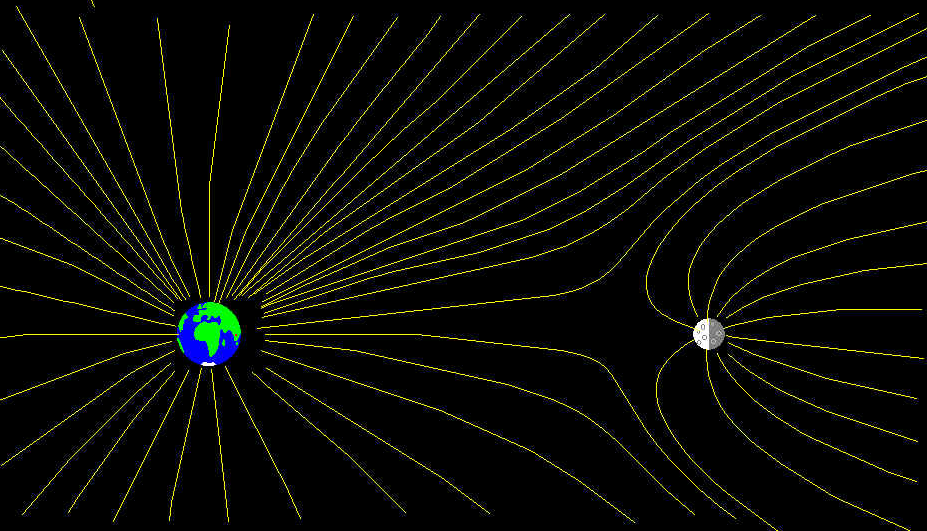
With the electric field, things are complicated by the fact that not all particles are charged (subject to the force) and that there are two kinds of electric charge (+) [positive] and (-) [negative]. We draw arrows representing the field directed to show the paths taken by particles with (+) charges on them. Particles with (-) charges follow the same paths, but in the opposite direction. We say that "like charges repel, opposite charges attract".

Just as near the earth the gravitational field is stronger than it is far away, so also are the effects of electric fields. The difference in strength of the electric field at various points in the field are called differences in potential, measured in volts. A standard one cell battery produces a more or less fixed difference in electric potential of about 1.5 V between its terminals.
All matter seems to be made of small units, called atoms. The atoms themselves comprise yet smaller particles. Most of the mass of an atom is concentrated in an extremely compact and dense body at the center, which comprises two kinds of partcles, the neutron (which bears no charge) and the proton [which has a (+) charge]. The protons and neutrons are bound together by forces which are irrelevant to tube theory.
There is one other kind of particle in the atom, the electron. Electrons have approximately 1/1800 the mass of a proton (and the neutron which is equally massive), but bear a (-) charge which is equal to that of the proton. The electrons in an atom reside in the space surrounding the nucleus, to which they are attracted by the charges present on the protons and electrons. By analogy with the planets in orbit about the sun, we say that the electrons orbit the nucleus, though they are held in place by electric, not gravitational forces.
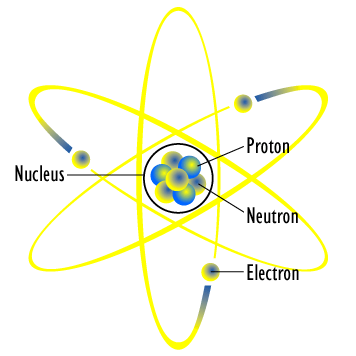
In ordinary matter, there are equal numbers of protons and electrons in the atoms comprising it, and the matter as a whole is neutral, bearing no net charge. It is common to say that neutral matter is "uncharged", but that is incorrect, since it possesses large amounts of charge, but the charges cancel so that there is no net charge.
Matter can however become charged, that is, be made to carry a net charge, either (+) or (-), by separating some of the electrons from their atoms. When one separates an electron from an atom, so that they are no longer bound to each other, one has a bare electron with a (-) charge, and a remnant of an atom, called an "ion", which bears a net (+) charge. The atom is said to be "ionized". Likewise, if the electron is then attached to another atom, then that atom has a net (-) charge, and is also said to be ionized and to be an ion.
Electrons may be separated from their atoms in a number of ways. One of the more common ones is by contact, in which two dissimilar substances come into contact with one another, and the one with more affinity for electrons "steals" some electrons from the other. This effect has been noticed since ancient times, when it was observed that pieces of amber when rubbed against fur or hair became charged, and could attract small bits of dust, hair, etc. In fact, the greek word for amber is "elektron", from which we get the name for the electron particle.
Another way in which electrons may be separated from their atoms is via "electron sharing". This occurs in conductors, especially metals, in which outermost electrons are weakly associated with individual atoms, and have a tendency to "come loose" and feel more associated with the overall positive charge of the nuclei of all the atoms as a whole rather than with any individual atom. This results in metallic objects being neutral as a whole, though most of the atoms comprising them are actually ionized, and the interior of the metal comprises ions, which are more or less fixed in place, and a sort of "electron gas" which fills metallic objects like air fills a balloon. The individual electrons move about quite rapidly (about sixty miles per second) due to heat energy, though this motion is random and there is no overall movement.
If an external electric field is applied to a good conductor, as by connecting a battery, then the electrons acquire a net movement toward the regions of higher potential, that is from the (-) toward the (+) connection. This is commonly called "electron drift", since the net motion is very slow (on the order of one inch per second) by comparison with the thermal motion. The drift of electrons in conductors due to an applied electric field is called "current" by analogy with water flowing in a pipe, and the motion of electric charges is called electric current.
Benjamin Franklin, during his investigations of electrical phenomena proved, in his famous kite flying experiment, that current electricity and static electricity were aspects of one and the same phenomenon. He guessed that the current particles flowing in metals bore the (+) charge. We now know that he guessed wrongly. This means that the direction of conventional current flow is opposite to that of the electrons which actually comprise the current in most conductors.
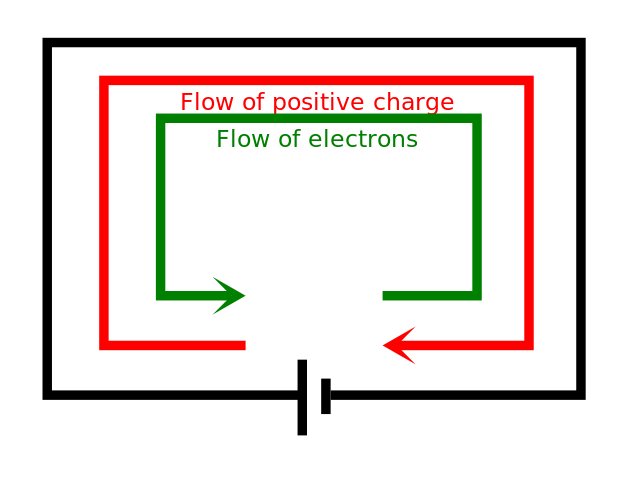
If we pass an electric current through a conductor, we find that it heats, the greater the current the greater the heat. If we heat a wire enough, eventually the electrons in it move fast enough that they escape from the attraction of the positive ions in the metal. This is the effect discovered by Frederick Guthrie, and rediscovered by Thomas Edison. It is much like heating water, and the electrons in effect "boil out" of the metal. At low temperatures, few if any electrons escape, but above a critical temperature which depends upon the metal, electrons are emitted into the surrounding space. This effect is used in electron tubes.
If a wire is heated in an evacuated tube, the electrons emitted into the surrounding space repel each other, and a sort of electron gas expands to fill all the space inside the tube. We call such a heated wire in an evacuated tube a cathode or filament. The source of electric current used to heat the filament we call the "A supply", and the circuit in which it flows the "A circuit".
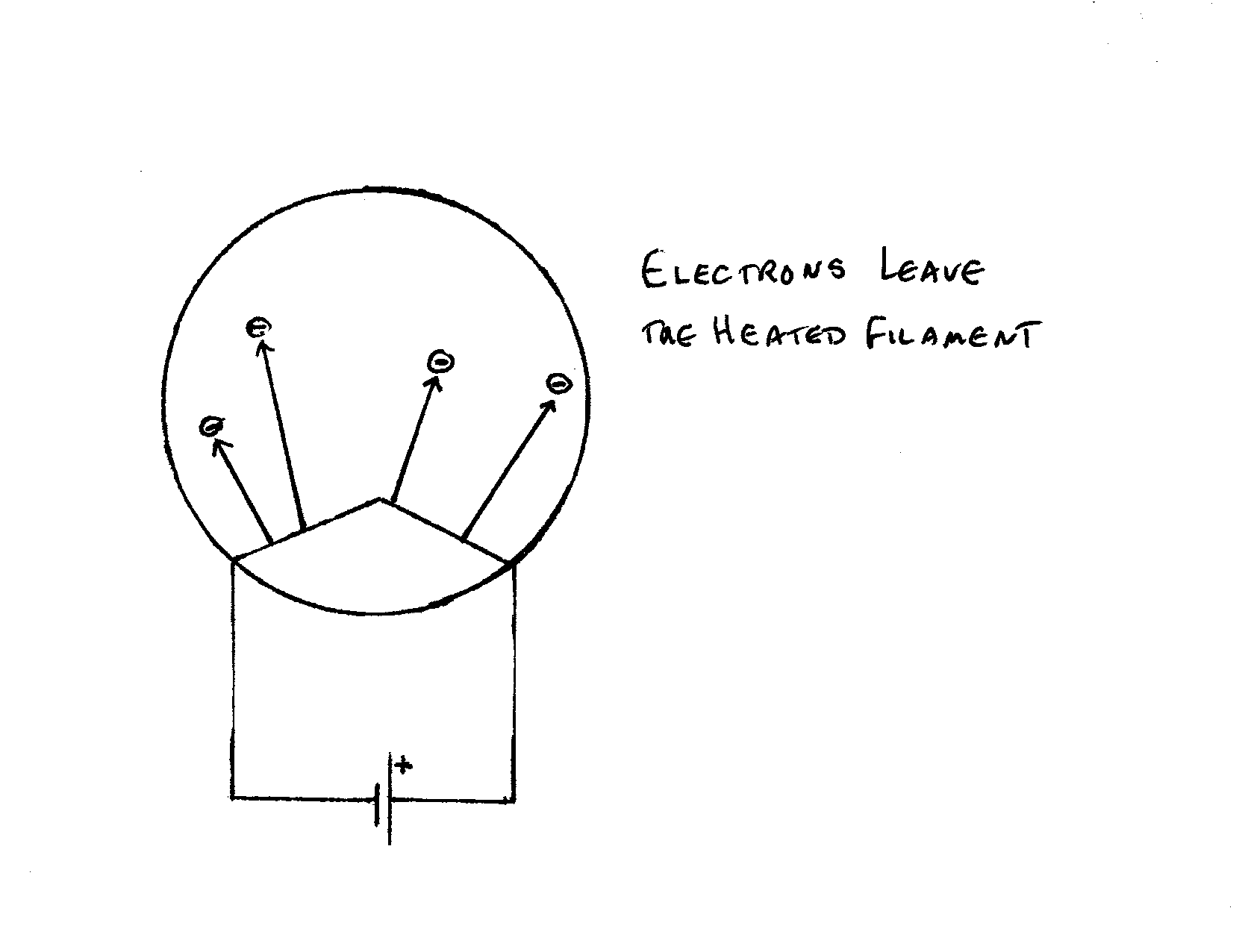
The electrons leaving the filament build up into a charge inside the tube, called a space charge. The negative electric field of the space charge repels electrons emitted from the filament. The electrons leave the filament with a very low velocity, and as they enter the space charge they slow. Eventually, the combined negative charge of the electron gas is able to turn back the slower electrons from the cathode, and some re enter the cathode and flow out the filament terminal connected to the (+) side of the A supply. The space charge builds up until the rate at which electrons are forced back into the cathode is the same as the rate at which they are emitted, and each time an electron enters the gas, one already present re enters the cathode.
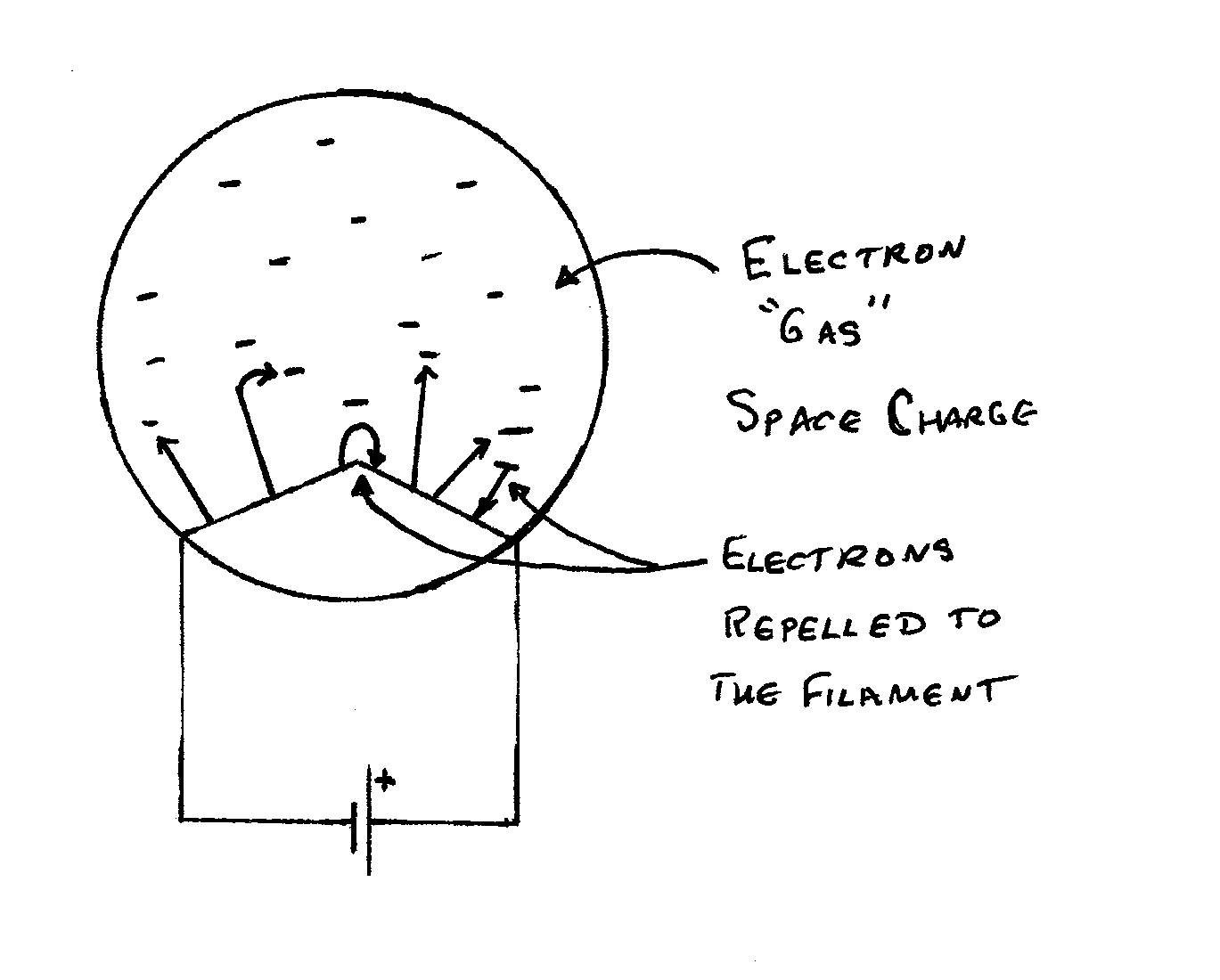
Suppose we add another electrode. What happens? As Thomas Edison found, electric current flows out of a plate of metal which is placed in the space charge, but only if it is connected to a source of positive potential. We call such a source of positive potential the "B supply", and the electrode to which it is connected the plate. The combination of a filament, plate, and possibly other electrodes in an evacuated chamber is called a vacuum tube. A vacuum tube with only a filament and a plate has two active elements and we call it a "diode", "di-" for two, and "-ode" for electrode.
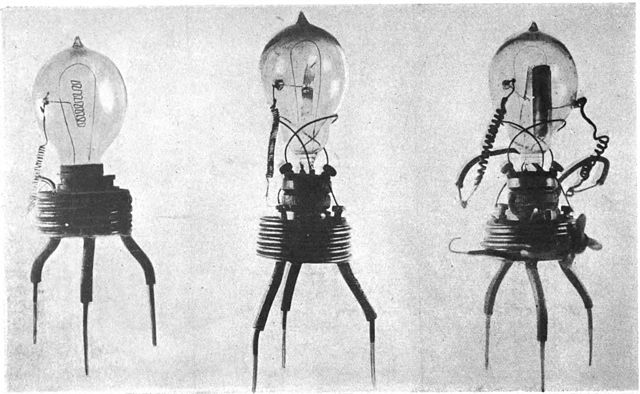
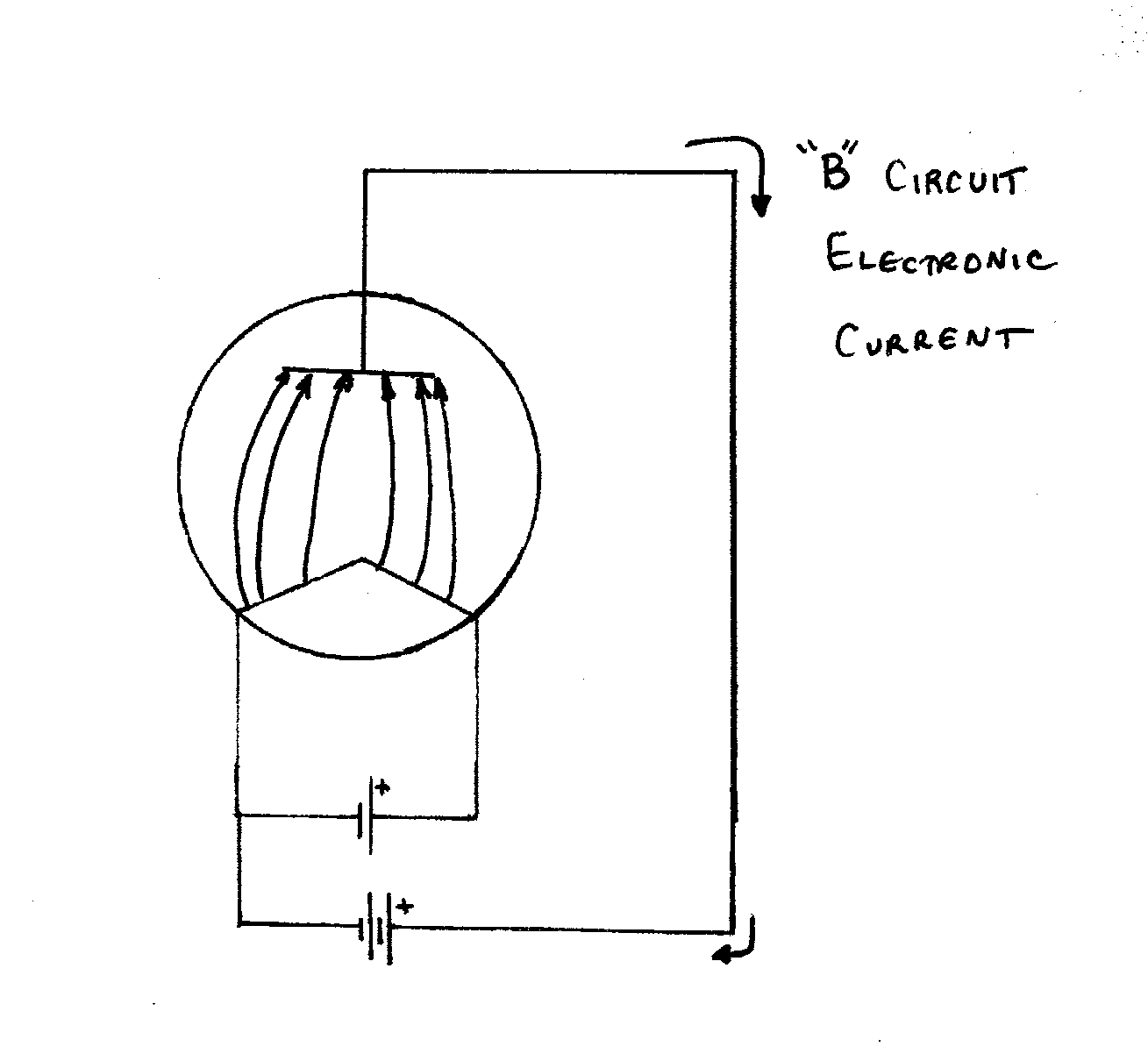
If we vary the B supply potential applied to the plate in a vacuum tube, we find that as the potental is increased, the current flowing in the B circuit increases correspondingly. At first, the current flowing increases fairly rapidly as the repulsion of the space charge drops, but then it levels off at a value which depends upon filament temperature and composition. The initial current available is called "space charge limited", since its value is limited by the repulsion of the space charge in the tube. Eventually, the space charge becomes depleted, and the ultimate current is called "emission limited", because it depends upon the ability of the filament to emit electrons. One can graph a curve of plate voltage versus plate current with a different curve for each value of filament current. These curves are called the "plate characteristic curves" for the tube.
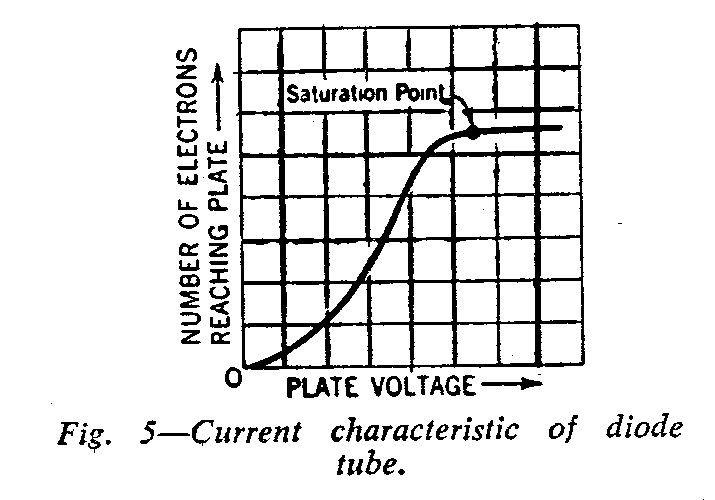
Suppose we reverse the connections of the B supply, such that the plate is connected to a negative potential? In this circumstance, current flow in the B circuit is negligible, because the plate is not heated, and does not emit electrons. Since the plate is negative, it repels the electrons in the space charge, and a void forms in the space charge in the vicinity of the plate.
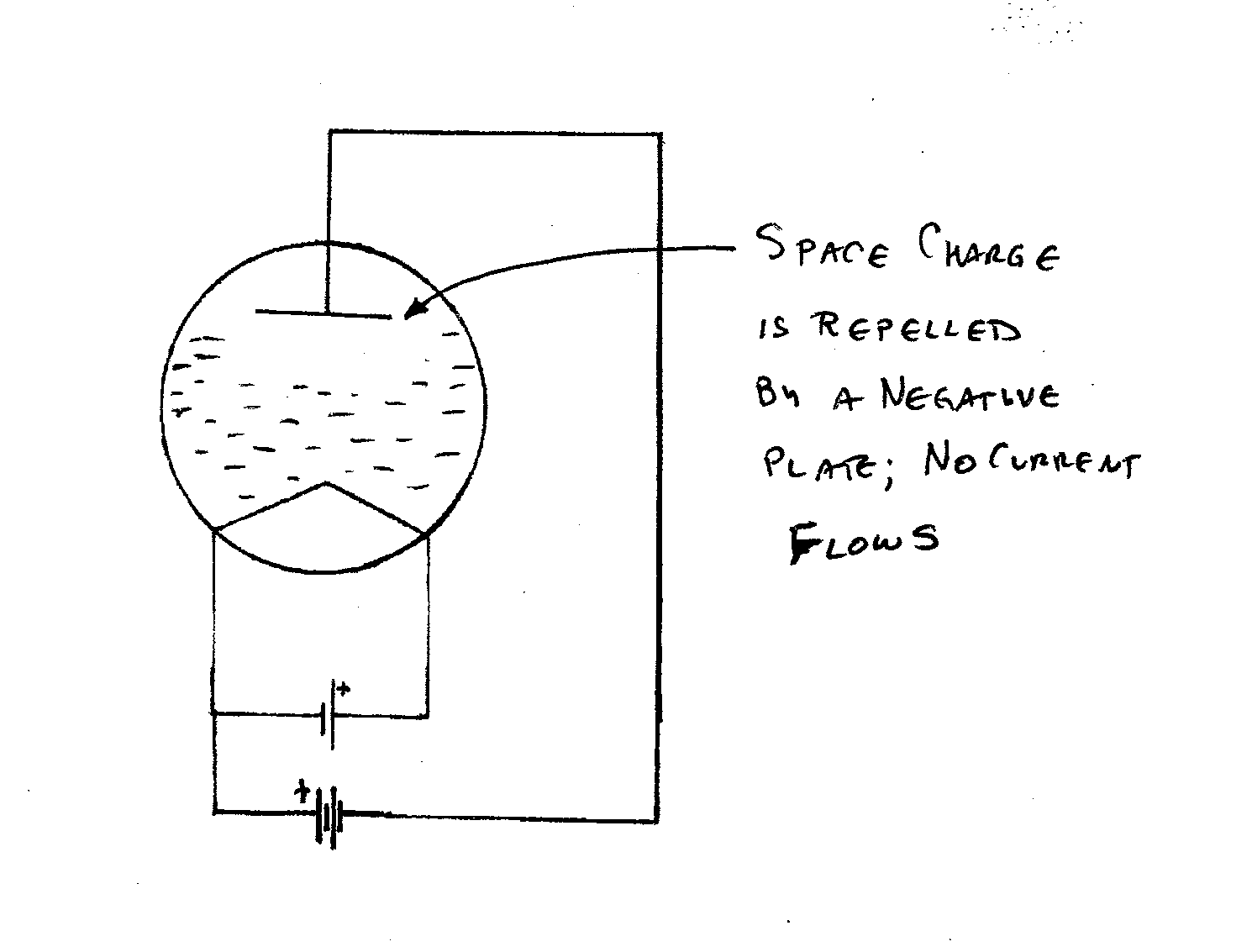
A vacuum tube, thus, acts as a sort of one way check valve. This use was first proposed by a britisher named Fleming. In Britain vacuum tubes were called "Fleming Valves", now just "valves", and they are still denoted as V1, V2, etc. in schematics. If we connect a tube's B circuit to a source of alternating voltage, we see unidirectional pulses of current flow through the tube. Each time the plate is positive relative to the filament, a pulse of current flows in the B circuit. This current can be filtered to pure direct current, like that supplied by a battery. This is the principle of the the diode detector for which Fleming obtained his patents, and the power rectifier.
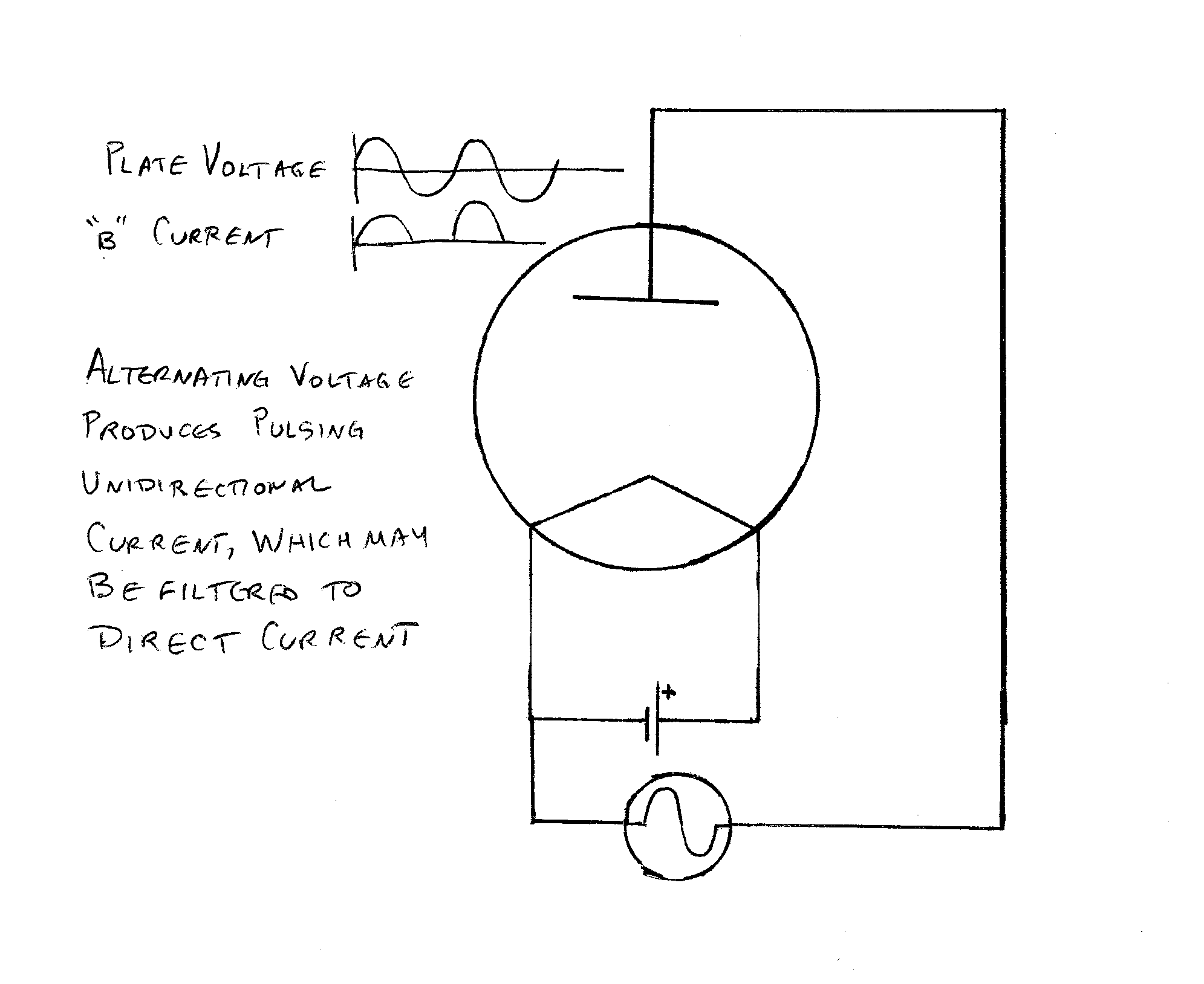
Lee de Forest interposed another element between the filament and the plate, so that it intercepted the path of the electrons as they traveled from the filament to the plate. He called this electrode a grid, since it was made in the form of a gridwork of thin wires.
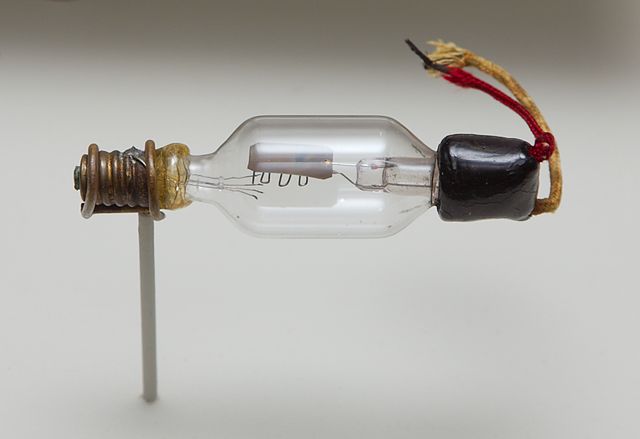
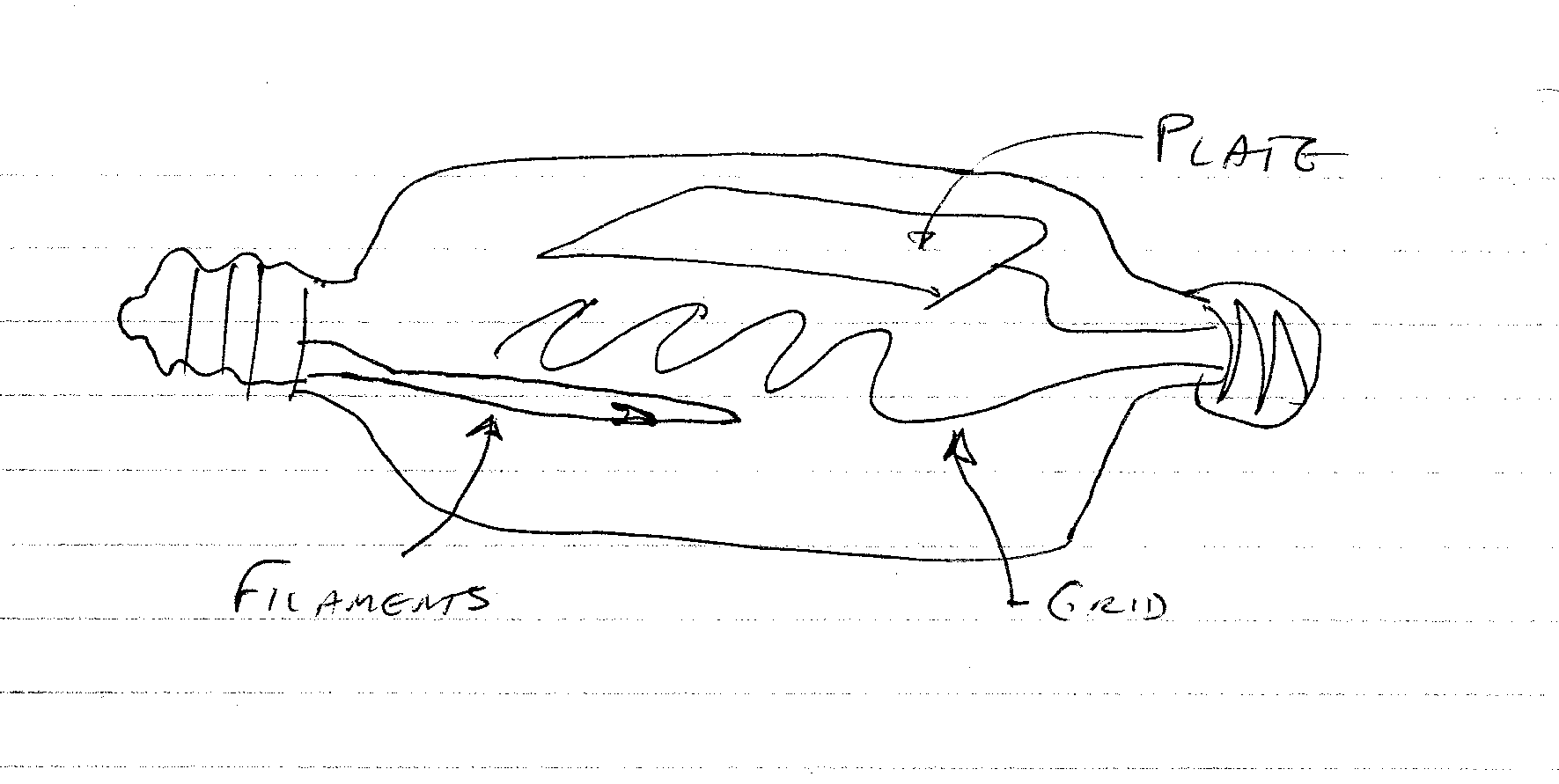
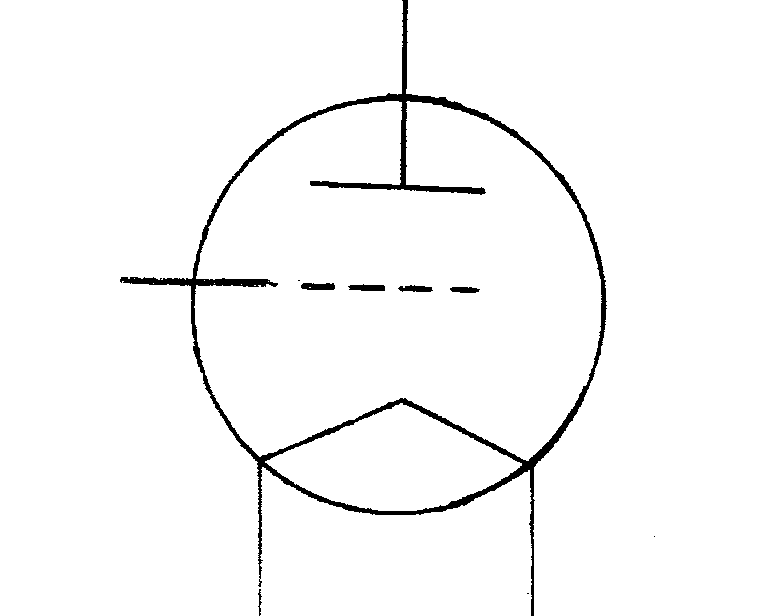
De Forest found that he could use a negative potential applied to the grid to repel electrons back toward the filament, and hence decrease the current flowing in the B circuit; more negative grid potentials result in less current flowing in the B circuit. This effect is analogous to squeezing a garden hose with water flowing in it. We find that the current in the hose decreases, and at the point where the hose is squeezed there develops a pressure differential or drop. Another analogy would be automobile traffic flow in a highway when there are lane closures. The automobiles back up behind the lane closure, and the number of automobiles moving through the blockage is reduced.
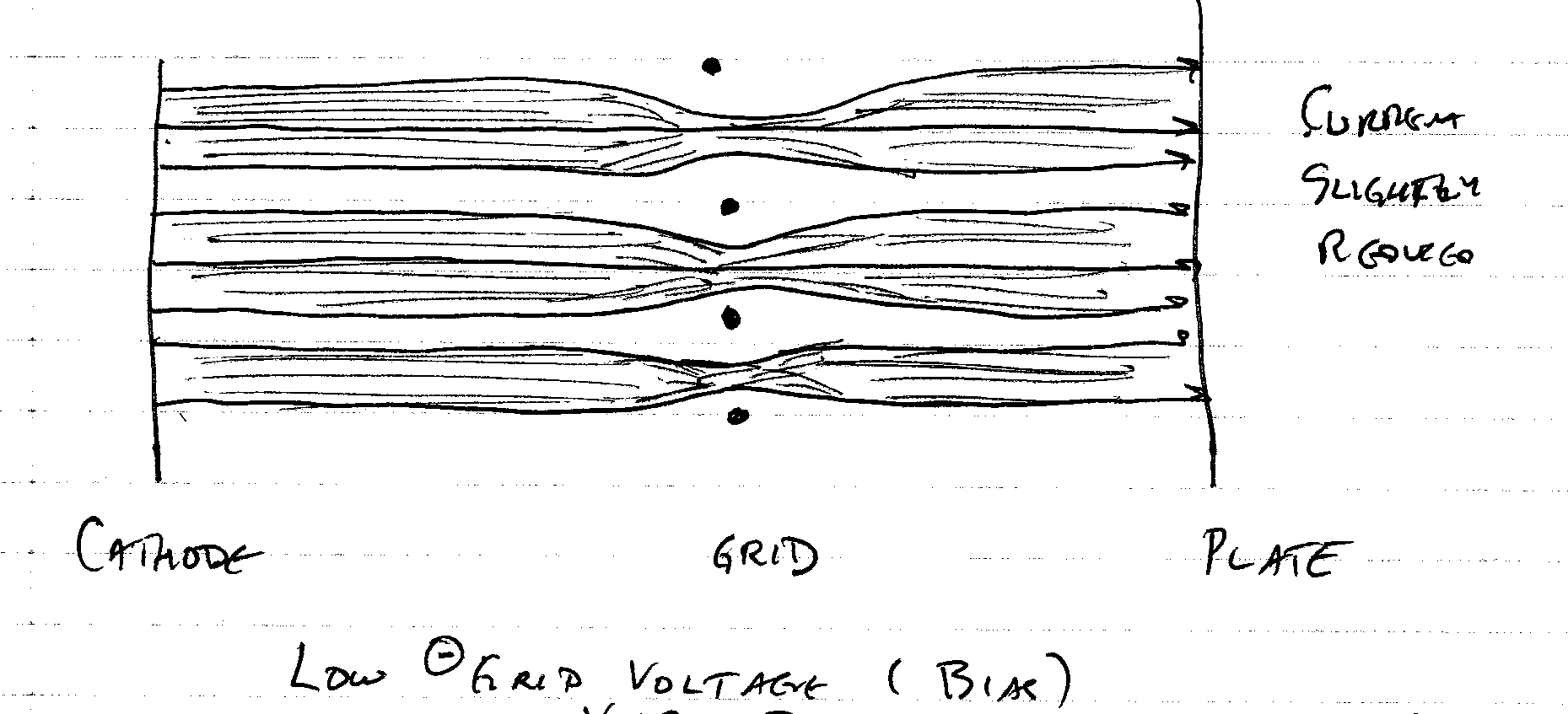
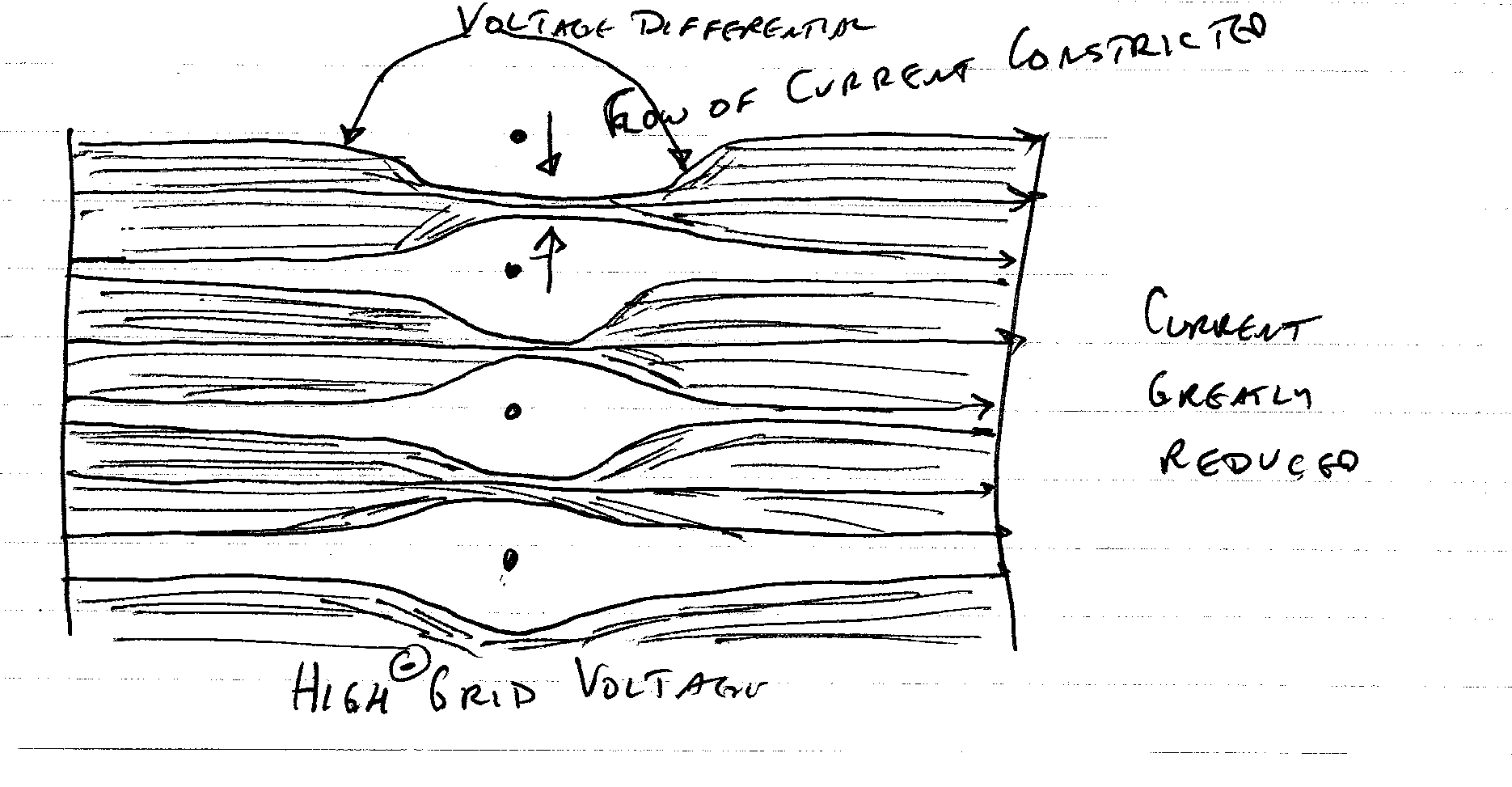
The source of negative potential for the grid is called the "C supply". Since the grid is negative, it repels the electrons in the space charge, and negligible current flows in the grid circuit. In the region between the grid and the filament there is increased negative charge, and the plate current then becomes space charge limited even at high plate voltages. The grid voltage exercises more control over the current flowing in the plate than the plate voltage does, and this effect can be used to construct an amplifier, in which small changes in grid voltage result in large changes in plate current. De Forest used this to make audio amplifiers, and called his three element tube the "audion". Since their use is not limited to this application, we now call them by the number elements, the "triode", with "tri-" for three and "-ode" for electrode.
We can graph the plate voltage versus the plate current available at each grid voltage and get a family of curves, one for each grid voltage. As with diodes, these curves are called the "plate characteristics", and tube manufacturers normally publish plate characteristic curves for the tubes they make.
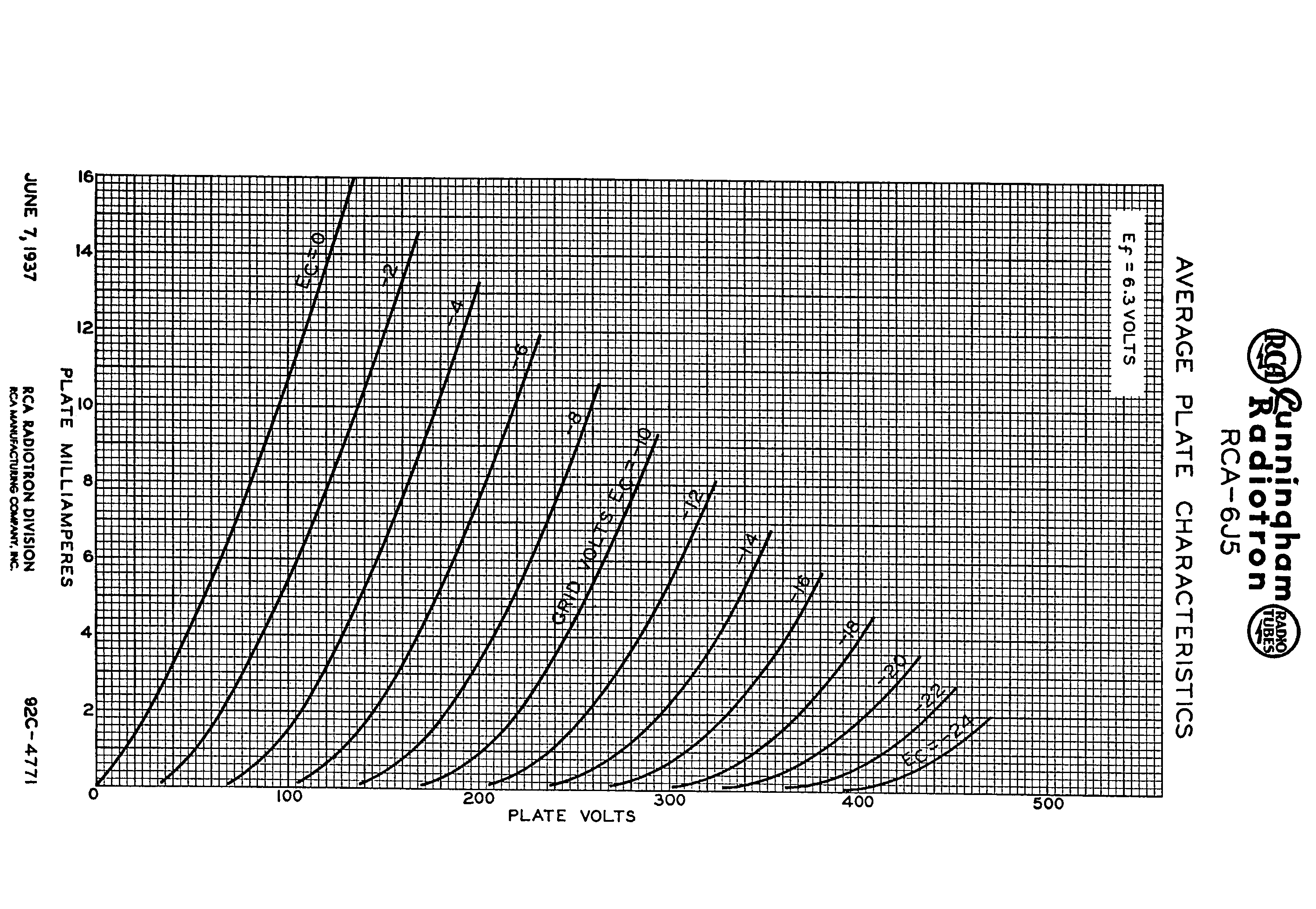
We see that by varying the voltage on the grid one can control the current flowing in the plate circuit. Since negligible current flows in the grid, it consumes no power, while the plate may deliver considerable power to the circuitry connected to it. This is the principle of amplification, in which negligible amounts of signal power input control significant power (ultimately derived from the B supply) delivered to a load, such as a loud speaker.
If some of the power available at the plate of the tube is fed back to the grid, it may become the source of the signal being amplified. This is the principle of the oscillator, and results in the tube being a signal generator. This principle was used in vintage radio transmitters and tube superheterodyne receivers.
We have covered the basic physics underlying electric charge, electric current, and atomic theory. We have covered the formation of a space charge in a vacuum surrounding a heated filament, and how this may be used to conduct an electronic current, and how this current is limited by the emission characteristics of the cathode. We have covered the principles of rectification and detection in vacuum tube diodes, and their plate characteristics. We have covered how a grid in a triode may be used to control the flow of current in a triode vacuum tube, and triode plate characteristics. We have seen that this control may be used to construct amplifiers and oscillators.
Rectification, detection, amplification, and oscillation are the most important functions performed by vacuum tubes in vintage radio equipments. All the other functions they perform are simply variations on these.
While tubes with more electrodes exist, and the specifics of their plate characteristics differ, all vacuum electron tubes use the same basic principles of operation. If you understand how diodes and triodes work and the meaning of the plate characteristic curves, then you have a basic working knowledge of how all but the most specialized vacuum tubes work.